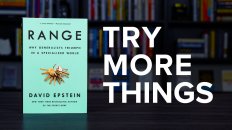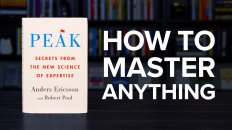Personal growth involves more than just consuming books, articles, or podcasts. Our brains aren’t very good at storing and retaining information. As a result, we often forget valuable insights and life lessons long before having a chance to make use of them.
How To Take Smart Notes by Sönke Ahrens is about how to better understand, retain, and benefit from great insights. The book exposes the flaws in common note-taking practices and presents a simple yet powerful way to capture insights and convert them into a growing web of knowledge. I highly recommend it if you’re a content creator, a researcher, or simply passionate about learning.
Let’s explore three of my favorite insights from the book.
1. The Better Way To Store Valuable Ideas
It’s no secret that our brains are ineffective at remembering information. While our minds can do many incredible things, reliably retrieving important details is not one of them. Over time memories fade, and valuable insights are forgotten, so it’s critical that we store insights and ideas in a more permanent way.
The Problem With Common Note-Taking Practices
Many people turn to digital note-taking apps like Evernote or Notion. Unfortunately, more often than not, these tools turn us into digital hoarders. We dump links, pdfs, quotes, and other random bits of data into these systems. Yet, while it’s convenient to put information into these tools, making sense of the data after the fact is often more complicated. As a result, we rarely revisit the information that we have gathered.
The same can be true for those that prefer physical references, including highlighting text, writing margin notes, or adding post-it notes. Once again, these are relatively convenient at the time of discovery but are less helpful for revisiting insights.
There are two potential issues with such practices. First, the notes may be so disorganized that it’s impossible to sort the relevant from the irrelevant. Second, if they are carefully organized by topic or theme, we’re unlikely to spontaneously rediscover them unless we’re intentionally exploring their original theme or context.
The Benefits Of A Simple, Standardized System
A great note-taking system frees you from having to keep track of everything in your mind. Furthermore, it must make it easy to understand, compare, and revisit insights over time. This is the key to developing a growing body of knowledge.
How To Take Smart Notes by Sönke Ahrens details the ‘slip-box’ system of Niklas Luhmann. He is widely considered one of the most influential social theorists, having published 58 books over 30 years, not including translations or titles later published based on his notes. His method was to convert interesting insights into bite-sized, linkable notes.
Here is a quick breakdown of his slip-box process:
- Whenever he encountered a new insight, he would immediately make a temporary or ‘fleeting’ note to capture it at the moment of discovery.
- Within 24-48 hours, while the insight was fresh in his mind, he would convert that quick note into a short but carefully written ‘permanent note.’
- He would then add the new note to his slip-box of notes by (a) filing it with related notes, (b) adding references to and from related notes, or (c) making a reference to it from an entry or ‘index’ note.
The power of this system is not just in collecting endless insights. Instead, it’s about developing ideas, comparing new insights with previous discoveries, and forming connections to deepen knowledge and understanding. Much of this is achieved through (a) the careful writing of notes and (b) the connections between them.
2. The Critical Step That Changes Everything
The way we gather and construct notes is as important as the system in which they are stored. Unfortunately, as hinted at earlier, many issues arise in common note-taking practices. So, let’s set the stage by exploring two quick examples.
First, we often take a passive approach to collecting insights. For example, we might highlight an interesting quote, write a quick note in a book margin, or save an article to a “read it later” app like Pocket or Instapaper. As a result, we fail to internalize a deeper understanding of the material at the point of original discovery.
Second, we often fail to capture the full context of a breakthrough. For example, we might have an interesting reaction to an article based on situational factors, like an ongoing project. If we fail to account for that larger context by simply storing a link or copying a quote, the deeper value of the insight or breakthrough can be lost forever.
Translate The Insight Into Your Own Words
We must take the time to rewrite the insight in our own words. Instead of simply highlighting text or copying a quote into a note-taking app, we must digest the details and describe it in our own words. A big part of this is separating the insight from the source and putting it within the context of our own life or work.
Doing so provides three significant benefits:
- Rewriting the insight is a powerful way to deepen our understanding of the original insight and test that we have a firm grasp on it.
- By taking the time to process the information and rewrite it in our own words, we can lock in our learning and boost retention.
- And finally, by translating the insight to fit our context, we increase its relevance to our lives and make it more valuable.
To be clear, each note should only convey a single idea or insight. It should be concise enough to fit on a single index card (1-3 short paragraphs), be written in complete sentences, disclose the source, and convey the information in a way that could be easily understood by someone unfamiliar with the source or context.
3. The Key To Deeper Learning & Retention
Individual insights have limited value on their own. Especially when they’re captured and considered within a single context or theme. The real power of knowledge comes from the connections that we create between ideas. Especially those that, at first glance, appear to be unrelated, as this can lead to interesting breakthroughs.
Unfortunately, traditional approaches to note-taking result in a top-down organizational structure that keeps insights siloed by theme, topic, or source. Everything to do with “Topic A” is in one pile or folder, and everything to do with “Topic B” is in another.
How The Brain Naturally Processes New Ideas
Our brains are not wired to organize insights into strict categories. Instead, we make connections between related concepts or ideas. Rather than a library of carefully segregated themes, our brains create complex webs of interconnected ideas. Some links are stronger and more literal, while others are weaker and more abstract.
How The Original Slip-Box Facilitated Connections
The original slip-box system leveraged physical index cards. Each card had a unique number for identification. For example, cards could be numbered 23, 24, and 25. But, if a new card was tightly related to an existing one, it could be inserted as “24b” or “24b2” to sit next to a tightly related card. Furthermore, entry points or ‘index’ cards were created to help reference independent cards that were related in some way.
How Modern Tools Are Both Easier And More Effective
Today we have apps that greatly simplify the linking of ideas. Popular solutions like Obsidian and RoamResearch are free or relatively inexpensive. They make it easy to create bi-directional links between insights. In other words, you can create two-way connections between independent notes to facilitate navigation and rediscovery.
For example, let’s say you created a note to explain the concept of ‘water.’ You might choose to add a reference to another note about ‘ice.’ In doing so, the note about ‘ice’ would automatically have a backlink reference to ‘water’ as a note that had linked to it. So, instead of each having to reference the other, a single link from one note to the next creates a two-way relationship.
Links Between Notes Are Mirrored In Our Mind
Individual ideas or concepts are easy to lose track of on their own. However, when we understand the relationship between two or more insights, each one becomes more developed in our mind. Furthermore, each new connection makes it more likely that we will reencounter related insights when they can be helpful in the future.
Critically, making connections between notes leads to similar links being created in our minds. As a result, this approach allows us to take a more intentional role in designing the architecture of our thinking. Every new insight can be compared to ideas already stored in our slip-box so that we can identify and create relevant connections.
Connections Lead To Creative Breakthroughs
Much of creativity is based on the remixing of existing ideas. Therefore, by creating a system that facilitates the navigation, comparison, connection, and rediscovery of ideas, you can unlock far greater opportunities for creative insights. Naturally, such insights are incredibly beneficial for authors, bloggers, and other creative roles.
For passionate learners, the discovery of exciting connections often serves as inspiration for further exploration and personal growth. Plus, reviewing insights often presents apparent gaps and questions on which to base further research. As a result, a well-managed slip-box is a powerful tool for expanding personal knowledge.
How I Plan To Take Smart Notes

After reading this book, I’m inspired to build a slip-box of my own. The process has just begun, but I plan to publish future content sharing the journey and process. The tool I’ve started to use is Obsidian, which is freely available for Windows, Mac, Linux, and other platforms (with mobile apps said to be coming in the future).
If you’d like to follow my slip-box journey, subscribe to The Rick Kettner YouTube Channel or The Rick Kettner Podcast. Doing so will also help you keep up with my latest reading lists, book summaries, and other educational content.
This summary of How To Take Smart Notes is not a substitute for reading the book. That’s because the original text provides a much richer learning experience. If you’re serious about applying these ideas, I strongly recommend that you pick up a copy.
How To Take Smart Notes is available from Amazon and Apple Books.
Do You Have A Question Or Comment?
Please visit the How To Take Smart Notes book summary on YouTube to share your thoughts in the comment section.


